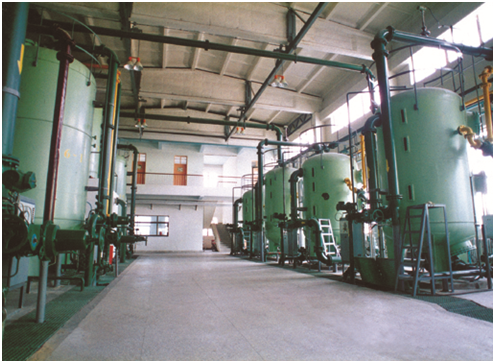Ion exchange equipment
Ion exchange equipment
I. Product Overview
Ion exchangers are divided into sodium ion exchangers, anion-cation beds, mixed beds, and other types. The shell of ion exchange column (filter) is generally made of hard polyvinyl chloride (PVC), hard polyvinyl chloride composite glass fiber reinforced plastic (PVC-FRP), polymethyl methacrylate (PMMA), polymethyl methacrylate composite transparent glass fiber reinforced plastic (PMMA-FRP), steel rubber lining (JR), stainless steel rubber lining, etc.
II. Purpose
Ion exchangers are mainly used for the preparation of pure water and high-purity water, and have been widely applied in many fields such as medicine, chemical industry, electronics, coating, beverage, and medium and high pressure boiler feedwater. It is used for the pre-treatment of boilers, thermal power stations, chemical industry, light industry, textile, medicine, biology, electronics, atomic energy and pure water treatment. It is also used for hard water softening and deionized water preparation in industrial production, as well as for decolorization and purification of food and medicine, recovery of precious metals and chemical raw materials, and treatment of electroplating wastewater.
III. Classification of Composition
Sodium ion exchanger: mainly used in the front-end treatment of boilers, thermal power stations, chemical industry, light industry, textile, medicine, biology, electronics, atomic energy and pure water treatment.
Yin-yang bed: The yin-yang ion exchange bed is also known as a double bed, which uses a series of cation and anion exchangers to achieve the purpose of desalting water.
Mixed bed: Mixed bed is a process in which anion and cation exchange resins are loaded into the same ion exchanger in a certain mixing ratio. Because the H ions and OH ions entering the water after mixed ion exchange immediately generate water molecules with a very low degree of ionization, the exchange reaction can be carried out very thoroughly. Generally, mixed beds are equipped with a first-stage composite bed to further purify the water quality. When the water quality requirements are not high, it can also be used alone.
IV. Working Principle
The working principle is ion exchange. During operation:
Cation resin (H-R) + (M+) → (M-R) + (H+)
Anion resin (OH-R) + (X-) → (X-R) + (OH-)
Where M+ represents metal ions and X- represents anions. The regeneration process is the reverse of this.
Failure Control of Ion Exchangers
The simplest process for ion exchange desalination water treatment is a single-stage composite bed desalination system composed of a cation bed and an anion bed. Some single-stage composite bed desalination systems use a unit system, where each system includes one cation bed (with a decarbonator), and one anion bed. During the ion exchange desalination process, whether the cation bed or anion bed fails first, they are both regenerated simultaneously. Other single-stage composite bed desalination systems use a header system, where cation beds or anion beds operate in parallel. The exchanger that fails is the one that is regenerated.
1.Detection and Control Principle
The adsorption order of strong acid cation resin for various cations in water is: Fe3+ > Al3+ > Ca2+ > Mg2+ > Na+ > H+. It can be seen that the adsorption capacity of metal ion Na+ in water is the weakest. Therefore, when ion exchange occurs, the various ion adsorption layers in the resin layer gradually move downwards, and H+ is finally displaced by other cations. When the protective layer is penetrated, Na+ in the lowermost layer is the first to leak. Therefore, monitoring the failure of the cation exchanger is based on sodium leakage. The reaction equation is (A represents metal cations, R represents the resin group): An+ + nRH = RnA + nH+. HCO3- + H+ = H2O + CO2↑.
The adsorption order of strong base anion resin for various anions in water is: SO42- > NO3- > Cl- > OH- > HCO3- > HSiO3-. It can be seen that the adsorption capacity of HSiO3- is the weakest. Therefore, when ion exchange occurs, the various ion adsorption layers in the resin layer gradually move downwards, and OH- is displaced by other anions. When the protective layer is penetrated, HSiO3- in the lowermost layer is the first to leak. Therefore, monitoring the failure of the anion exchanger is based on silicon leakage. The reaction equation is (B represents acid anions, R represents the resin group): Bm- + mROH = RmB + mOH-.
2.Control Points and Control Methods
Since the header system includes the unit system and has advantages such as fully utilizing resin, improving the water output capacity of the exchanger, and reducing acid and alkali consumption, we mainly discuss the ion exchange desalination water treatment system based on this structure in our research. Taking the pure water station in the protein separation workshop of Chengdu Institute of Biological Products as an example, the system is a header water treatment system with a structure of sand filtration - activated carbon filtration - coarse filtration - cation bed - first anion bed - second anion bed - mixed bed - fine filtration - pure water tank. The water production capacity of the system is 5 t/h. In the study of failure control in the system, we propose the concept of unit failure control, which fully utilizes the advantages of the header water treatment system for failure control.
(1) The removal rate of various organic solutes by RO is higher than that by NF membranes.
(2) The removal rates of different organic solutes are not the same, and some even differ greatly (for example, the absorbance removal rates of RO and NF membranes for acetic acid are 95.34% and 81.45% respectively, while the absorbance removal rates for aniline are 61.50% and 46.82% respectively).
3.Effluent Water Quality
After desalination by the single-stage composite bed, the conductivity (at 25℃) of the raw water is lower than 10μS/cm, and the silicon content in the water is lower than 100μg/L.

.jpg)
.jpg)

